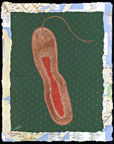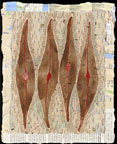Articles on Indian contemporary art by Swapna Vora
|
Talha Rathore: Unclaimed Territories July 21, 2008 (click on the small image for full screen image with captions.) In the beginning were the single celled bacteria, the dangerous viruses, amoebas, paramecia, yeasts, protozoa and all beauty and life, as best we know, originated from them. So dangerous and yet so beautiful, these lively, lovely creatures, no two alike, each with its own characteristics! To know them requires infinite patience, microscopic observation and a longing to know and understand our origins, the ebb and flow of existence. Pakistani Talha Rathore's face has shades of brown flushed with pink, with attractive high cheekbones and lovely, huge eyes. Wearing simple black and brown, she commented, "I was told to always wear light colors, because I am so dark." She is very modest, hesitant and laughs that in her country, which admires pink and white complexions and blue eyes, she was quickly described as dark. (Admiration for the others rather than themselves? A distaste for the self?) "So now I adore color!" Talha says she arrived here and was already adjusting to maps, subways and groceries and learning to live and to make a living in a new country. And then September 11 happened, an unbelievable, shattering tragedy. She, like most of us from the Indian subcontinent, painfully remembers being observed as 'the other', the outsider. Those of us who came from the subcontinent to become American had already been through so many tragedies: colonization, partition, communalization, the loss of friends, neighbors, livelihoods and passports. Now, we were 'the other'. Painting was far away. Her beloved child was born. She loved feeling him when she was pregnant but grew depressed. Then she remembered the microscopes of her days as a medical student in Lahore. An excellent medical student yes, but a rebellious one! She had started doing everything: playing volley ball, roaming around, everything that an artist might do, everything except medical studies. And then her grades arrived. "What do you want to do?" her shocked family asked. 'To paint', she said and sought permission to become an artist. The college term was ending in two weeks! Youthful rebellion eased the transition. She was accepted into the best art college in Pakistan and began to learn the arts of making fine brushes a few hairs thick, wasli paper, sticking sheets together to achieve strength and smoothness, rubbing sheets with shells to burnish them until they shimmered like glass, and finally, meditatively, taking hours to paint one tiny square of paper. Friction between surfaces involves the forming and breaking of many contacts. But she did not let go of unicellular bacteria! Talha's philosophical names for her works, 'Breakthrough', 'Predictably Rational', 'A New Earth', 'Reason For God', 'Power of Now', 'Awakening', 'Change of Heart', 'Remember Me', 'Home and Away', and 'The Heart Settles' carry traces of popular books, New York, the foreigner's tale, and one immigrant's claims on her new territory. She paints subtle stories of the closely observed, the observer and the minute glorious details of creation. Breakthrough "Shell like, unicellular, something that protects you from the outside," she says. "It can imply both hiding and a breakthrough. Bright hot colors of heated plains." She looked into DNA, and was told it carried everything. "Such details! I could not see something there, yet it is carrying so much information, but just looking, one can't make this out." Predictably rational "Four different uni-cellular forms! They show the experience of being observed. Those forms are so fascinating, I couldn't get rid of them after one or two paintings. They are so similar yet they have their individual character. They can't lose their character even if they try." Like us. "Politics has affected us permanently, I am sensitive to this." Reason for God These are stretched out, magnified pictures. Their delicate, fragile beauty is revealed only under minute observation under a microscope, stretched out and observed closely to find details, to understand. Life stretched out for information? Yes, she nodded silently. Talha has taken part in 'Karkhana' which means a place for producing collaborative work. Asians work comfortably on each other's artwork! Traditionally miniatures were painted collaboratively. In 2003, Muhammad Imran Qureshi initiated a series of paintings for the experimental exhibition, 'Karkhana', (Workshop). Qureshi contacted five Pakistani miniature painters, trained at Lahore's National College of Arts, but now working in different countries. He requested each artist to start two paintings on wasli paper and send them to the other artists to add their strokes. They were to be passed around until every artist had worked on each painting. Talha remembers, "Six artists, yet so cohesive, so harmonious! I enjoyed maintaining my style and yet not disturbing the composition. I enjoyed that so much. Very challenging. So encouraging." In Pakistan, like elsewhere, there are state sponsored forms of art and original bursts of creativity and expression distinct from any diktat. Salima Hashmi was the head of the National College of Arts in Pakistan. A farsighted, respected patron of young artists, she represented and encouraged the first generation of modern Pakistani artists, like Talha. Talha adds, "I am in touch with so many artists and curators. So glad they are becoming internationally known. There is this scenario where you can't openly display your work but you can show it elsewhere. The internet has given Pakistani artists so much. Salima Hashmi was responsible for encouraging artists to go outside the system, outside the limited conditions. Salima supports artists and actually helped me grow more and more."
|
Articles on Indian contemporary art by Swapna Vora





